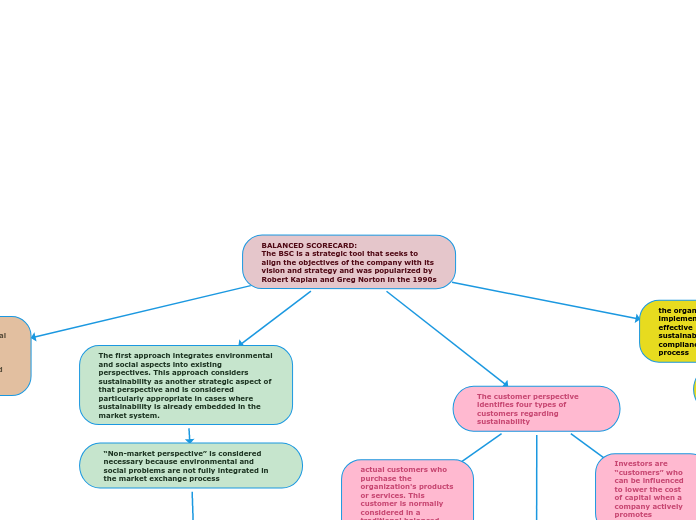BALANCED SCORECARD:
The BSC is a strategic tool that seeks to align the objectives of the company with its vision and strategy and was popularized by Robert Kaplan and Greg Norton in the 1990s
the organization can implement an effective sustainability compliance reporting process
includes environmental auditing skills and tracking the costs of reporting compliance
improvement of the organization's research and development capacity
Learning, the final perspective, involves the training of personnel at all levels of the company in the triple result of sustainability: economic, social and environmental
focuses attention on sustainability rather than burying it in other strategies
The customer perspective identifies four types of customers regarding sustainability
actual customers who purchase the organization's products or services. This customer is normally considered in a traditional balanced scorecard
Investors are “customers” who can be influenced to lower the cost of capital when a company actively promotes sustainability
affected by the actions taken by the organization. This group bears the social costs when an organization shuns its social responsibility. The third group is the government that imposes fines for non-compliance with environmental regulations.
The first approach integrates environmental and social aspects into existing perspectives. This approach considers sustainability as another strategic aspect of that perspective and is considered particularly appropriate in cases where sustainability is already embedded in the market system.
“Non-market perspective” is considered necessary because environmental and social problems are not fully integrated in the market exchange process
The third approach develops a separate scorecard, known as the Sustainability and Capacity Balanced Scorecard (SBSC). This approach assesses each of the four perspectives across the triple bottom line, economic, social, and environmental.
The financial perspective would incorporate at least three factors.
The second factor includes the benefits of the environmental processes, products and services that generate income. Sustainability carries a number of intangible benefits, such as conserving resources and a healthier climate
The third factor of the financial perspective is the increase in the market value of the company due to its sustainable activity
The first of these factors is the cost of compliance, innovation, and the cost and risk of default.
It has four perspectives: financial, customer, internal business processes, and learning and growth. Measurable goals are established, monitored and evaluated within each objective
measures success in sustainability and must meet four criteria:
1-must address the triple bottom line of sustainability: economic, social, and environmental performance
2-must have performance measures that can be clearly understood and communicated
3-must add value and be integrated into the organization's value-added systems
4-must be supported by existing management tools and resources.

